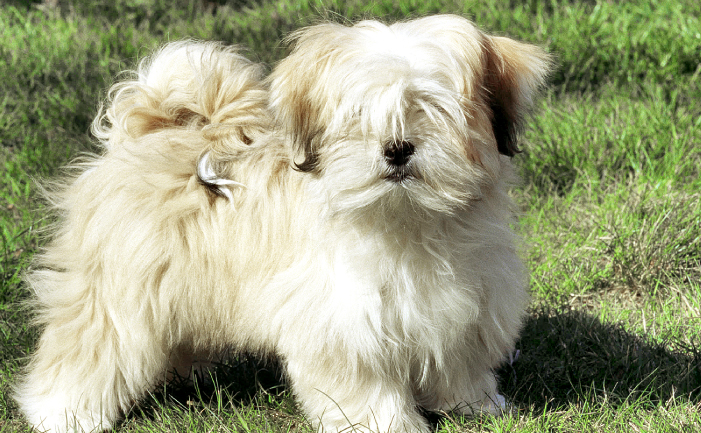Breed: Lhasa Apso
Temperament: gentle, aloof
Maintenance: high
Lifespan: 12-14 years
Recommended for: less active people
History
The name Lhasa Apso literally means terrier of Tibet (Lhasa is the capital of Tibet). They are also called the lion dog of Tibet. There are three dog breeds that have their origin in Tibet. As well the Lhasa Apso, there is also the Shih-tzu and the Tibetan Terrier. Like these the Lhasa Apso was probably developed for its temperament as well as its looks.
The dogs were thought to be a favourite of the Dalai Lama and were often given as gifts to palace visitors. The dogs were exclusive to Tibet for centuries and were not introduced to Europe until the early 1900s where they were exhibited along with Shih-tzus and Tibetan Terriers as one breed. All three breeds were recognised in their own right by the 1930s. The first Lhasa Apso came to Australia in the 1960s.
Appearance
The distinguishing characteristics of the Lhasa Apso are its long thick coat of hair and its small size. The coat grows all over the body, even between the toes. The coat acts as an insulation barrier, keeping the dog warm in winter, cool in summer. The coat will grow to ground length, even covering the eyes, and is neither soft nor silky. The hair is held off the eyes by long eyelashes and a black nose sticks out from underneath a long moustache.
The Lhasa Apso has a short, compact body and grows to around 25-28cm high (some males may grow slightly larger have a slightly longer body). The breed has a distinctive regal stance and gait, with the head carried high and the tail curved over the back.
Colours include: gold, sand, honey, dark grizzle, slate, smoke, particolour, black, white and brown.
Temperament
The Lhasa Apso can seem aloof, especially with strangers but it is this quality that makes them attentive and alert to anything strange. According to breeders the dogs will assess a stranger and not permit any interaction if they are not comfortable with the situation. These dogs are affectionate and loyal to those they are familiar with, but they like to be treated with respect. Lhasa Apsos will bond particularly well with one person and will prove to be a loving and good natured companion dog.
Grooming
It takes a lot of dedication to keep a Lhasa Apso in full coat. While the dog is young it must be brushed every day and bathed once a week. Mature dogs are easier to care for but dogs that are pets and not being groomed for showing are often clipped to reduce maintenance. The full adult coat with a hard textured outer coat does not develop until the dog is around 6 or 7 years of age. This coat needs to be well groomed once a week.
Breeders say that Lhasa Apsos should be blow dried after the bath, to prevent moisture remaining on the skin. The face hair is kept pulled back from the face with bands or plaits. The face hair is allowed to fall over the eyes when showing in exhibition.
Breeders recommend that the Lhasa Apso’s coat is not clipped until the dog is 9-10 months old when it is developing a more mature coat. The dog will need weekly baths and every day grooming until that age and then it can be clipped just prior to the first summer and then every mid autumn and late spring after that. A clipped dog may need a bath every fortnight to three weeks and the occasional brush to remove excess hair. If your clipped dog has hair trimmed around its face and eyes it is important maintain the short cut around the eyes. Help with coat maintenance can be obtained from a pet store or grooming salon. There are many different styles of clip for the Lhasa’s coat.
All dogs whether clipped or not must have the hair between the feet pads trimmed and the ears plucked. Lhasa Apsos do lose some coat in the summer.
Maintenance and diet
The Lhasa Apso needs a quality dog diet, including raw chicken wings, raw bones, good quality dry food and meat. They may have a tendency to become overweight if overfed. Lhasa Apsos do not need routine exercise and are not suitable for long walks. They will self exercise around the home.
Health and lifespan
Lhasa Apso should live 12-14 years and indeed most will live to 16 years or more. They do not suffer from serious hereditary conditions, however the occasional luxating patella (loose knee joint) may be seen in the breed. A vet can identify this condition in a puppy.
Recommended for
Although these dogs can be happy with families they do not suit life with rough and tumble kids. An older family who respects their Lhasa Apso will get a loving pet. Only clipped dogs are suitable for the elderly. For the less active person, who can dedicate time to a pet at home, a Lhasa Apso will make a good companion.
National contacts
To find up-to-date contacts for breeders, contact the following organisations.
Dogs NSW
http://www.dogsnsw.org.au/breeders-directory
Email: [email protected]
Phone: 1300 728 022 (NSW only) or (02) 9834 3022
Fax: (02) 9834 3872
Dogs Victoria
http://www.vca.org.au
Email: [email protected]
Phone: (03) 9788 2500
Fax: (03) 9788 2599
Dogs ACT
http://www.actca.asn.au
Email: [email protected]
Phone: (02) 6241 4404 – Fax: (02) 6241 1129.
Dogs West
http://www.cawa.asn.au
Email: [email protected]
Phone: (08) 9455 1188
Fax: (08) 9455 1190
Dogs SA
http://dogssa.com.au
Phone: (08) 8349 4797
Canine Control Council of Queensland
http://www.cccq.org.au
Email: [email protected]
Phone: (07) 3252 2661
Fax: (07) 3252 3864
Tasmanian Canine Association
http://www.tasdogs.com
Email: [email protected]
Phone: (03) 6272 9443
Fax: (03) 6273 0844
Dogs NT
http://www.territorydogworld.com
Email: [email protected]
Phone: (08) 8984 3570
Fax: (08) 8984 3409



